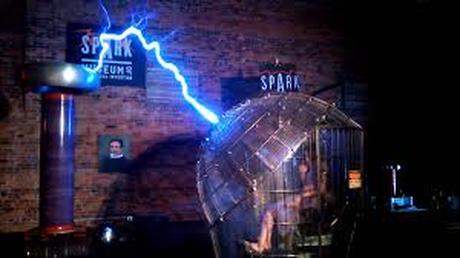Faraday's Cage:
|
Faraday cage or Faraday shield is an enclosure formed by conductive material or by a mesh of such material. Such an enclosure blocks external static and non-static electric fields by channeling electricity along and around, but not through, the mesh, providing constant voltage on all sides of the enclosure. Since the difference in voltage is the measure of electrical potential, no current flows through the space. Faraday cages are named after the English scientist Michael Faraday, who invented them in 1836.
A Faraday cage operates because an external static electrical field causes the electric charges within the cage's conducting material to be distributed such that they cancel the field's effect in the cage's interior. This phenomenon is used, for example, to protect electronic equipment from lightning strikes and electrostatic discharges. Faraday cages cannot block static or slowly varying magnetic fields, such as the Earth's magnetic field (a compass will still work inside). To a large degree, though, they shield the interior from external electromagnetic radiation if the conductor is thick enough and any holes are significantly smaller than the wavelength of the radiation. For example, certain computer forensic test procedures of electronic systems that require an environment free of electromagnetic interference can be carried out within a screened room. These rooms are spaces that are completely enclosed by one or more layers of a fine metal mesh or perforated sheet metal. The metal layers are grounded to dissipate any electric currents generated from external or internal electromagnetic fields, and thus they block a large amount of the electromagnetic interference. See also electromagnetic shielding. The reception or transmission of radio waves, a form of electromagnetic radiation, to or from an antenna within a Faraday cage is heavily attenuated or blocked by the cage. |
|
In 1836, Michael Faraday observed that the excess charge on a charged conductor resided only on its exterior and had no influence on anything enclosed within it. To demonstrate this fact, he built a room coated with metal foil and allowed high-voltage discharges from an electrostatic generator to strike the outside of the room. He used an electroscope to show that there was no electric charge present on the inside of the room's walls.
Although this cage effect has been attributed to Michael Faraday's famous ice pail experiments performed in 1843, it was Benjamin Franklin in 1755 who observed the effect by lowering an uncharged cork ball suspended on a silk thread through an opening in an electrically charged metal can. In his words, "the cork was not attracted to the inside of the can as it would have been to the outside, and though it touched the bottom, yet when drawn out it was not found to be electrified (charged) by that touch, as it would have been by touching the outside. The fact is singular." Franklin had discovered the behaviour of what we now refer to as a Faraday cage or shield (based on Faraday's later experiments which duplicated Franklin's cork and can)
Although this cage effect has been attributed to Michael Faraday's famous ice pail experiments performed in 1843, it was Benjamin Franklin in 1755 who observed the effect by lowering an uncharged cork ball suspended on a silk thread through an opening in an electrically charged metal can. In his words, "the cork was not attracted to the inside of the can as it would have been to the outside, and though it touched the bottom, yet when drawn out it was not found to be electrified (charged) by that touch, as it would have been by touching the outside. The fact is singular." Franklin had discovered the behaviour of what we now refer to as a Faraday cage or shield (based on Faraday's later experiments which duplicated Franklin's cork and can)
Operation:
A Faraday cage is best understood as an approximation to an ideal hollow conductor. Externally or internally applied electromagnetic fields produce forces on the charge carriers (usually electrons) within the conductor; the charges are redistributed accordingly (that is,electric currents are generated). Once the charges have rearranged so as to cancel the applied field inside, the currents stop.If a charge is placed inside an ungrounded Faraday cage, the internal face of the cage becomes charged (in the same manner described for an external charge) to prevent the existence of a field inside the body of the cage. However, this charging of the inner face re-distributes the charges in the body of the cage. This charges the outer face of the cage with a charge equal in sign and magnitude to the one placed inside the cage. Since the internal charge and the inner face cancel each other out, the spread of charges on the outer face is not affected by the position of the internal charge inside the cage. So for all intents and purposes, the cage generates the same DC electric field that it would generate if it were simply affected by the charge placed inside. The same is not true for electromagnetic waves.If the cage is grounded, the excess charges will go to the ground instead of the outer face, so the inner face and the inner charge will cancel each other out and the rest of the cage will retain a neutral charge.Effectiveness of shielding of a static electric field depends upon the geometry of the conductive material. In the case of a non linear varying electric field, and hence an accompanying varying magnetic field, the faster the variations are (i.e., the higher the frequencies), the better the material resists penetration, but on the other hand, the better it passes through a mesh of given size. In this case the shielding also depends on the electrical conductivity of the conductive materials used in the cages, as well as their thickness.
A Faraday cage is best understood as an approximation to an ideal hollow conductor. Externally or internally applied electromagnetic fields produce forces on the charge carriers (usually electrons) within the conductor; the charges are redistributed accordingly (that is,electric currents are generated). Once the charges have rearranged so as to cancel the applied field inside, the currents stop.If a charge is placed inside an ungrounded Faraday cage, the internal face of the cage becomes charged (in the same manner described for an external charge) to prevent the existence of a field inside the body of the cage. However, this charging of the inner face re-distributes the charges in the body of the cage. This charges the outer face of the cage with a charge equal in sign and magnitude to the one placed inside the cage. Since the internal charge and the inner face cancel each other out, the spread of charges on the outer face is not affected by the position of the internal charge inside the cage. So for all intents and purposes, the cage generates the same DC electric field that it would generate if it were simply affected by the charge placed inside. The same is not true for electromagnetic waves.If the cage is grounded, the excess charges will go to the ground instead of the outer face, so the inner face and the inner charge will cancel each other out and the rest of the cage will retain a neutral charge.Effectiveness of shielding of a static electric field depends upon the geometry of the conductive material. In the case of a non linear varying electric field, and hence an accompanying varying magnetic field, the faster the variations are (i.e., the higher the frequencies), the better the material resists penetration, but on the other hand, the better it passes through a mesh of given size. In this case the shielding also depends on the electrical conductivity of the conductive materials used in the cages, as well as their thickness.


